Forest resources and context of Papua New Guinea
According to ‘Forest and Land Use Change in PNG 2000-2015’ (PNGFA, 2019), Papua New Guinea (PNG) has around 36.1 million hectares (ha) of forested land, which constitutes 78% of the total land area.

Land surface
46.3million ha
Forest cover
33.6million ha
Production forest
8.8million ha
Forest ownership
3% publicly
Forest resources in Papua New Guinea
Types of forest
The country falls within the world's moist tropical rainforest zone. With its rugged terrain, and with forests stretching from sea level to an altitude of over 4,000 m, the forest types vary from mangrove forest, swamp forest and low altitude forest, to lower montane forest, upper montane forest, and dry evergreen forest. Three forest types however dominate PNG’s forest land: low altitude forest on plains and fans (Note: “fans” are alluvial fan deltas), low altitude forest on uplands, and lower montane forest. Almost the full extent of the forested area is defined as primary or otherwise naturally regenerated forest, PNG having only about 62,000 ha of forest plantations.
More than 70% of the forest land is still intact or has not been disturbed by anthropogenic activities. Most of the forest degradation is caused by commercial logging (10.8%) followed by gardening (8.3%), fire (3.1%) and other disturbances (1.3%). Commercial logging is common in low attitude forest, on both plains and fans and uplands. About 80% of commercial logging occurs in Western, Gulf, West New Britain, East New Britain and West Sepik provinces. Gardening activities occur in the three major forest types, while fire occurrences are prevalent in savannah, woodland and scrub forests.
PNG contains more than 7% of the world’s biodiversity in less than 1% of the world’s land area. It is home to 18,894 described plant species, 719 birds, 271 mammals, 227 reptiles, 266 amphibians, and 341 freshwater fish species, plus some 600 species of coral and 3000 species of reef fish.
Forest ownership in Papua New Guinea
The ‘Papua New Guinea Policy on Protected Areas 2014’ supports the development and management of a National Protected Area Network in PNG. PNG’s new Protected Area Classification System comprises National protected areas (National Parks, Marine Sanctuaries, National Heritage Areas and Special Management Areas), as well as Regional protected areas (Community Conservation Areas and Locally Managed Marine Areas). From a handful of Wildlife Management Areas established in the 1970s, there are now 58 Protected Areas totaling 1,724,800 ha i.e. 4% of the country’s land surface (plus, a little under 1% of the seas, with 334,400 ha), with many more yet to be gazetted.
It is estimated that only 3% of the country's overall land area is publicly owned, most of which are towns and cities, and the remaining 97% is owned or possessed by customary landowners. Customary land tenure includes the rights to almost all above-ground natural resources, including forests, and landowner groups are consequently legally entitled to be involved in decisions concerning the management of their forest.
key figures
| Land surface | 46.3 million hectares |
|---|---|
| Forest cover | 33.6 million hectares (72.5%); mostly primary or other naturally regenerated forest |
| Production forest | 8.8 million hectares designated for production |
| Forest ownership | 3% publicly owned 97% privately owned |
| Annual change rate | -0,01% per year; over the past 25 years (1990-2015) |
Source: FAO, 2015
See also: Global Forest Ressources Assessment 2020, FAO



